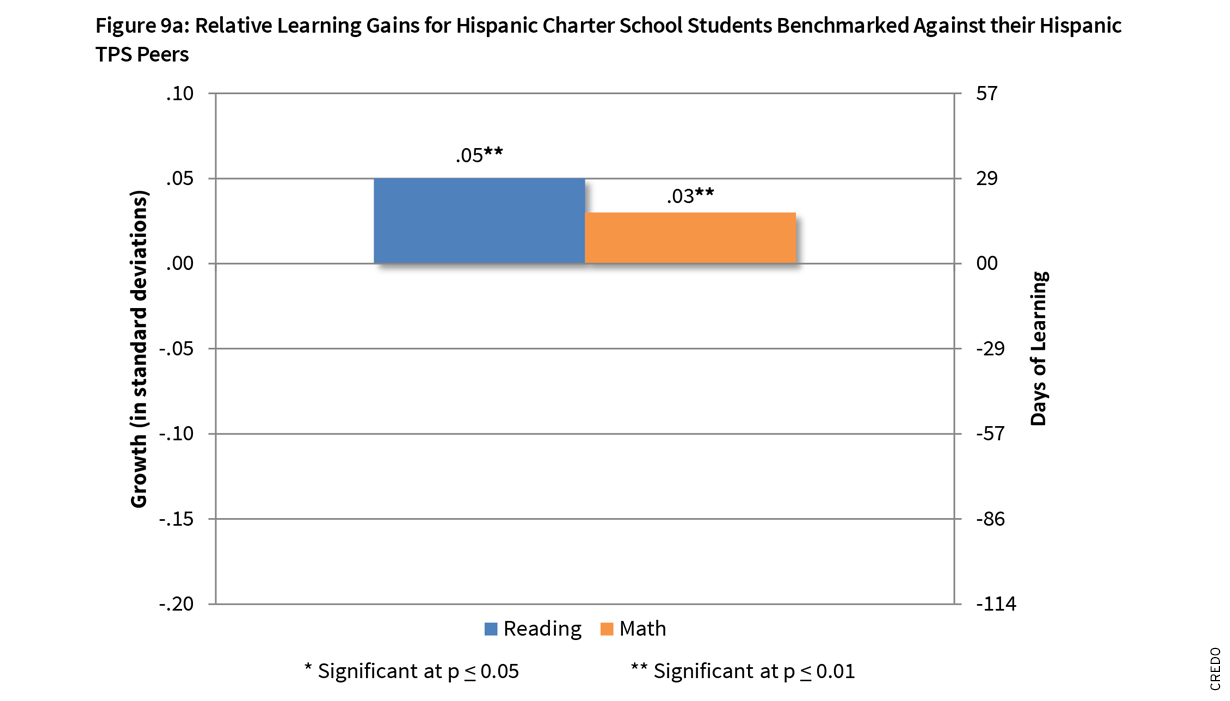When it comes to giving parents a choice in their children’s public education, quality matters most. The state of Texas has been making a concerted effort to raise the quality of its public charter schools through sound policy reform, effective implementation, and resources to help practitioners zero in on improvement. This effort is paying off, especially for Hispanic students. That’s the upshot of two recent studies that looked at Texas charter school students in K-12 and in college.
A study by Stanford’s Center for Research on Education Outcomes (CREDO) finds that over the course of three years, Texas charter school students on average gained the equivalent of 17 more days of reading instruction per year than their district school peers. In math, results were about even.
This is a major improvement over previous CREDO studies, which showed that students in Texas charter schools actually learned less than their district school counterparts. What’s especially encouraging is that Hispanic students, who make up a larger share of the student population in Texas than in most other states, demonstrated some of the biggest gains. Hispanic charter students gained 29 days of learning in reading and 17 days of learning in math compared to their peers in district schools.
Furthermore, students accelerated gains the longer they attended a charter school. By the final year of the study (2014-15), charter school students had gained the equivalent of 40 extra days of learning in reading and 46 extra days in math.
The impact of attending a charter school wasn’t uniform. Charter schools in Texas range from campuses at dropout recovery centers and residential treatment centers to college preparatory schools with a STEM focus. As you would expect in any diverse education system, some schools serve students better than others. At IDEA Public Schools, students gained the equivalent of 74 extra days of learning in reading. KIPP Austin’s students gained 86 days of learning in math. On the other end of the spectrum, students in online charter schools suffered the equivalent of more than a year of learning loss. This could be due to a variety of factors that merit further scrutiny.
Why the improvement in results for most students, and what do these findings portend for the future of charter school policy?
One big move was the Texas legislature’s passage of SB2 in 2013. The law put a much greater focus on quality in charter school authorizing, for instance by mandating the closure of any charter school that fails to meet academic or financial benchmarks for three consecutive years. In the final year of the CREDO study – the first under the new quality regime introduced by SB2, 60 charter schools were closed, compared to 47 total in the three years prior.
While school closures aren’t exactly reasons to celebrate, Texas’s higher closure rate does indicate that the state is serious about ensuring quality in charter schools. The CREDO results seem to bear this out. Further study about student results in subsequent years will help to confirm the trend. Based on these early results, other states should look to Texas’s example as they seek to move the needle on quality in their own charter schools.
States should also consider how Texas’s charter school ecosystem is set up to reinforce the goals of state education policy. The Texas Charter Schools Association, a non-governmental entity that provides support to the state’s charter schools, has spent a lot of time helping schools identify their quality gaps so they can focus on areas that require the most urgent attention. An organization that has a big-picture perspective on the issues facing charter schools and can guide school leaders toward higher quality is an essential element of an effective state charter school movement.
How about the second study I mentioned at the top, the one that shows charter school graduates succeeding in college? That comes from author Richard Whitmire and The 74. They studied college graduation rates among alumni of nine top charter school networks and found that these graduates were between three and five times as likely as demographically similar district school graduates to complete college. Three of the nine networks – KIPP, YES Prep, and IDEA – were born and have a substantial presence in Texas. And all 3 charter school networks have been awarded the annual Broad Prize for Public Charter Schools, which recognizes the best charter management organization in the country.
Given the major benefits – economic and otherwise – that a college degree makes possible, it’s clear that attending a high-quality charter school in Texas can be a life-changing opportunity for a student. And none more so than for Hispanic children growing up in areas like the Rio Grande Valley, which IDEA serves, or inner city Houston, where YES Prep is based.
If the American dream is to mean anything for children from low-income backgrounds, they need access to a public education that helps them overcome economic and social barriers and achieve at high levels. The Texas blend – legislative commitment to higher quality, better oversight, and supportive partners that help charter schools diagnose and solve problems – is a promising one for states that want to see more of their students succeed in K-12 classrooms and beyond.
— Nina Rees
Nina Rees is the President and Chief Executive Officer of the National Alliance for Public Charter Schools.



